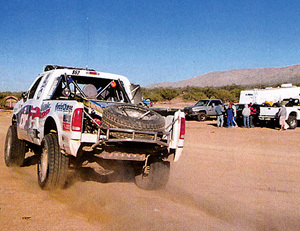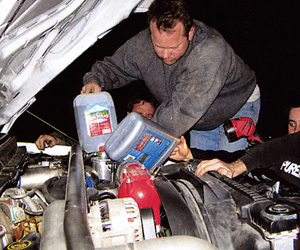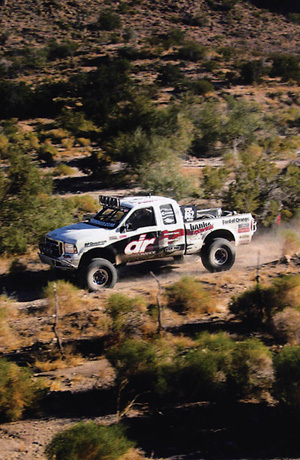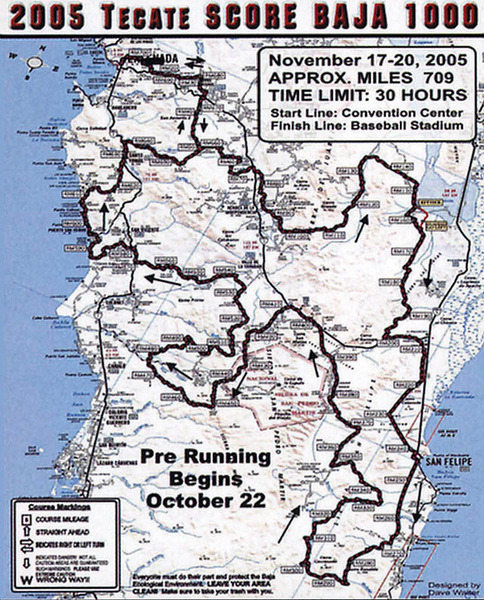The Toughest Terrain on the Planet
Diesel Power March 2006
Gale Banks himself hits the dirt as a driver in the Baja 1000
We Race the Baja 1000 in a 6.0L Super Duty
Editor’s Note:The Baja 1000 is the world’s most famous off-road race. It’s held every year in Mexico on the Baja peninsula, just south of San Diego, California. It’s a race that started as a bet between some friends more than 40 years ago. And it’s evolved into a motorsport that takes hundreds of drivers, thousands of mechanics, and millions of dollars of race vehicles over some of the worst “roads” in North America. The Baja 1000 is the ultimate test of man and his machine, and the kind of experience you just can’t believe until you see it for yourself.
–David Kennedy
At a race like the Baja 1000, many of the true tales can sound stranger than fiction. And only a storyteller, like our man Bob Bower, could even come close to capturing the adventure we had as it unfolded last November.
Truck #862 Baja 1000 Race Report
No successful race ever starts at the green flag. That said, the stock fullsize Ford Super Duty race truck of Team Banks delivered more success than non-success in its first diesel-powered Baja 1000 assault. Of course, we wanted to get across that finish line and see that checkered flag in the allotted time, but this year it was not to be. But, for every loss and every victory at the Baja 1000, there is a story to be told. This year, our tale began with more than 40 people, 12 chase vehicles, and a race truck that runs on Number 2 diesel

A quick profile of our race machine is in order. It’s a 6.0L diesel Ford F-250 Super Duty. It weighs more than 8,000 pounds. It has a chrome-moly safety cage, an on-board navigation system, a breathing apparatus, the toughest tires you can buy, and the biggest shocks you’ve ever seen. And it seats three
Our strategy would be simple. Gale Banks–yup, that Gale Banks–would take the truck off the starting line and run the F-250 for the first 70 miles of the Baja 1000 out of Ensenada. Having enough power was not a question. We were competing in a racing class full of “stock” pickup trucks, yet we had more torque than the gasoline vehicles running in the unlimited classes. We weren’t cheating. It just felt like we were.
At the Starting Line
Having Gale Banks join the team as the driver who would take the truck at the start was significant. Although his race experience is better known for the records he set at the Bonneville Salt Flats, his off-road driving experience came mostly from frequent off-road driving on his property in the Yosemite Valley. Baja is not Yosemite, but Banks is no slouch either. With a bit of coaching during his prerun miles, he was quick to pick up on the added elements that are important to driving in an off-road race situation.
After more than 300 high-horsepower Trophy Trucks, buggies, and motorcycles hit the course, our “slow” class gets to bring up the rear. We took the green flag at just after noon. Up the wash and on to the graded road at the end of Avenue Ruiz, we came upon the first surprise for Banks. At race mile 4 was a steep silt hill. The hill wasn’t the surprise for him. It was there on the prerun we made the night before, and we knew it would be busy when we got to it on race day. No, the hill wouldn’t be a problem, we were in a four-wheel-drive diesel F-250 on the largest and strongest BFGoodrich tires available. We had plenty of ground clearance and weighed more than four tons, so simply motoring to the top was not a question. That is, of course, unless the course was blocked by other two-wheel-drive race cars who were either stuck, or about to be stuck.
And there they were. Many of them were motionless, but a good number of them were still spitting up dirt and dust in their attempt to get up the hill. Then (as if that weren’t enough) from the bottom of the hill, we saw there was a brush fire at the top. The fire, fanned by helicopters–used as chase vehicles by the big-money teams–overhead, was going full force when we got to it. Now, we’ve done a lot of things in Baja races, but never have we pointed the race truck at a 20-foot wall of flames and tried to drive through it–that is, until this year.
What Could Possibly Go Wrong
What the heck–with a cloud of thick smoke to blind us, and a steep silty hill to slow us, what could possibly go wrong? With a responsive throttle and a little sphincter clench, we blew right through the flames. From then on, it was just a matter of dealing with the booby traps set in the racecourse by the locals, and we were on our way

Now We’re Racing
Banks handled the terrain and race situation with control. We got to the road crossing at Ojos Negros (race mile 35) and felt a certain sense of liberation from the jam up of people and booby traps in the first section. Banks started to get completely tuned into the truck. He was driving it very well–fast, controlled, and well within the limits.
We caught up and passed our first diesel competitor, the 6.5L Hummer H1 of Chad Hall, in the Tres Hermanos area (race mile 50). Mike Winkle was at the wheel. He was running a conservative pace in the rough and accelerating on the straight flat sections, which is very smart driving for that stage of the race.
But, Banks wanted to go faster. Our Ford wanted to go faster. Yet, our pace was well ahead of the race plan. We were running a winning pace for the Baja 1000–not a finishing pace. The job at hand was to deliver a fit race truck to the next drivers. We stuck to the job, slowed down, and held our speed.
All too quickly we got to the highway and pulled into our pit for a driver swap at race mile 70. Wow. It was over for Gale Banks and me. Out of the truck and the next guys got in and went. Steve Krieger at the wheel with Diesel Power’s trusty Editor David Kennedy in the right seat. From there, my job was to run chase truck #10 ahead to Borrego at race mile 200 and be ready to rendezvous with the Super Duty sometime after dark.

Lost Our Steering
Not an hour later, I heard reports over the radio that our F-250 had reached the top of the summit at race mile 90 and exploded the steering box. Between the weight of the 4-ton truck and those huge 39-inch tires, the forces on the steering box must be enormous. Luckily, Team Banks made sure to mount a spare box on the truck, just in case something like this happened. It took the guys a little more than an hour to change the steering gear and drain some ATF from the transmission to refill the steering system. By then, the sun had set and it was time to fire up the HID KC lights and motor on to Borrego through the dreaded silt beds that lay ahead.
We knew communication with the race truck would be spotty over the next few hours as the F-250 roared southeast down the backside of the summit. We didn’t hear the reports from the team that our Super Duty was charging toward the El Diablo dry lake at speeds close to 90 mph. It was only later that we learned how well the 6.0L Super Duty surged through the sand and ate up off-road obstacles that swallowed other vehicles alive.
Gasoline Sucks!
I heard over the radio relay network that there were problems with Team Banks sister truck (a Class 7 Toyota Tacoma 4×4) that could be in trouble. The report was not great. The Toyota Tacoma was guzzling gasoline. More than twice the amount we planned for it to use. Engineer Dylan Evans gave me and chase truck #10 a new mission. Instead of meeting the Super Duty at race mile 200, I had to get two gasoline dump cans to race mile 244. Meet the Toyota, fuel it, and then refill the gas cans at the Pemex station in San Felipe, so I could fuel the little Toyota again at Morelia Junction around race mile 350. I was off toward San Felipe within minutes, knowing that we could be stuck for hours at a Mexican military checkpoint we would have to pass through.

Stuck In Two-Wheel Drive
Over the radio, we heard that our diesel F-250 had come into the Borrego pit at race mile 200 around 8 p.m. The other chase teams fueled the truck, made its second driver swap, and sent it off into the night. It wasn’t long before the radio crackled with more bad news. Shortly after the Borrego pit stop, our F-250 broke the front axle’s ring-and-pinion gearset. We’d been running the truck in four-wheel-drive for more than 200 miles. We were now a two-wheel-drive race truck–no, check that, an 8,000-pound two-wheel-drive race truck. Oh yes, and it was on its way to run the San Felipe loop, some of the loosest terrain the truck would face on the entire course.
The Class 7 Tacoma got to me at race mile 244 at about 2 a.m. on Saturday. We dumped the fuel into the tank, and it scooted off into the dark. It had caught up to our Ford Super Duty, stuck in the dreaded sands of the Matomi Wash, and pulled it out in the wee hours of the morning. The two trucks ran together for the rest of the night, like David and Goliath. Without four-wheel-drive in the Super Duty, the wash crossings would have been a blood bath if the little Toyota weren’t there to pull it out.

There was nothing for us to do while both trucks were so far south, so we drove north to a nice spot south of San Matias along the highway at race mile 390 and parked. We monitored the radio and napped. You know how it works: sort of sleep, sort of listen. Neither gets done well, but rest happens. Naptime ended at dawn, but the trucks were still making their way up from the San Felipe loop. We go to race mile 404 and set up the pit. Our Goliath F-250 pulled into the pit first. Our third and final driver swap happened, and the final driver got out of the driver seat and Steve Krieger got back in to take the truck up around the Mike’s Sky Ranch loop and back toward Valle De La Trinidad. Dylan Evans brought the Tacoma race truck in on the heels of our Super Duty. That truck swapped drivers, gassed, and took off again into the dust and sunrise.
Change of Plans
Knowing that our chances of finishing with either truck in the required 30-hour time limit was unlikely, our chase teams hung out at race mile 404 for some time. We shared a light breakfast and some heavy stories about our experiences over the last 12 hours. Then, the radio call none of us wanted to hear came in. Our Tacoma was broken on the road to Mike’s. The reports were sketchy, but it sounded like a rear spring pin had broken and the axle was sliding out from under the truck. We were going to have to send in a chase team to fix the Toyota.
We loaded chase truck #10 with tools and parts and hustled off to fix the broken truck. The rest of Team Banks packed up our support trucks and headed north to a wide spot on the highway just before Valle De La Trinidad at race mile 540. The radio reception was good there, but the good radio reception delivered more bad news about our F-250. Somewhere around race mile 460, the bolts holding the driver-side full-floating rear axleshaft sheared in the wheel hub. The axleshaft was sliding out of the axlehousing! Our four-wheel-drive F-250, that was running through some of the worst terrain Mother Nature had to offer (in two-wheel drive) for the last 200 miles, was now a one-wheel-drive 8,000-pound anchor. Our Toyota race truck was still 20 miles behind the Ford, fixing it’s own axle problem, and both trucks were so far from our chase crews they were basically on their own.
Now finishing the race was a remote prospect, and surviving was the priority. Chase truck #4 was over on the Pacific side of the peninsula and was instructed to travel overland to race mile 460 to lend assistance. The plan was to get the F-250 out of a wash it was stuck in and nurse it to BFGoodrich’s pit at race mile 475. Then, we’d plan to get it to the highway and drive it under its own power back up to Ensenada.

We Still Came Home Winners
Sometime just after lunch on Saturday, both of our trucks timed out of the race. They failed to clear a checkpoint in the required time limit. Krieger was able to get the Super Duty unstuck by airing down the right rear tire to 5 psi. Then, to be a good guy, he pulled another race truck out of the wash, after it had been stuck there since late the night before. Even in one-wheel drive our F-250 could still tow.
With both race trucks in full recovery mode, we stopped in Valle De La Trinidad for tacos, chatter and fuel. The long drive back to Ensenada seemed unusually short on Highway 3. Most of us got to the hotel in Ensenada at about 3:30 p.m. on Saturday.
Damn. It was a great time. How lucky can a guy get? Team Banks was all back and safe from a grand adventure by 7 that night.
We didn’t win. We didn’t finish. But, we didn’t quit either. Old Mr. Baja got the upper hand this time. But, we’ll be back again.
Life is a one-lap race!

